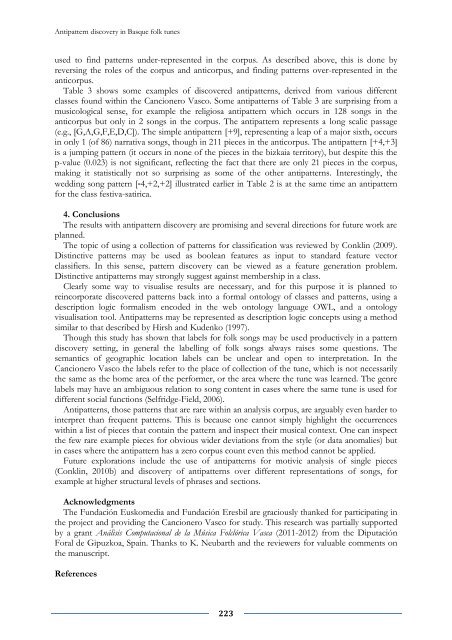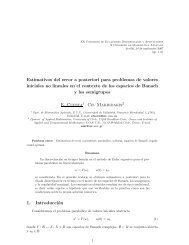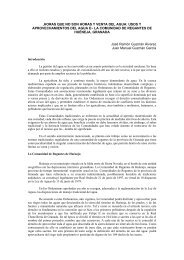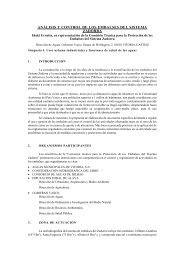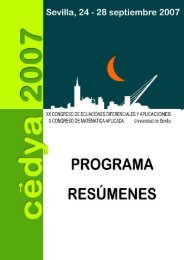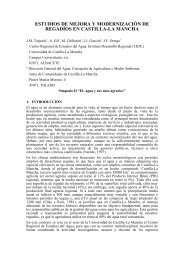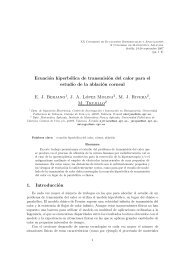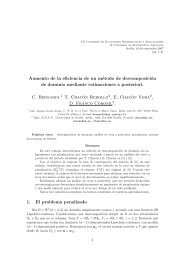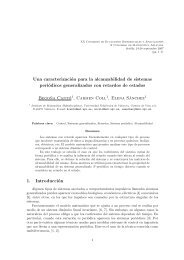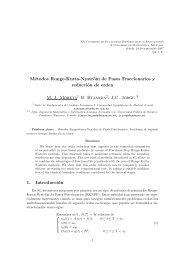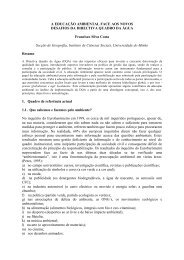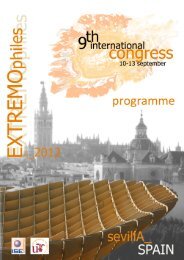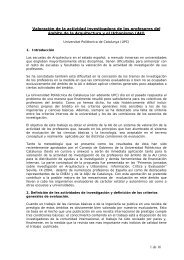LIBRO DE ACTAS (pdf) - Universidad de Sevilla
LIBRO DE ACTAS (pdf) - Universidad de Sevilla
LIBRO DE ACTAS (pdf) - Universidad de Sevilla
Create successful ePaper yourself
Turn your PDF publications into a flip-book with our unique Google optimized e-Paper software.
Antipattern discovery in Basque folk tunes<br />
used to find patterns un<strong>de</strong>r-represented in the corpus. As <strong>de</strong>scribed above, this is done by<br />
reversing the roles of the corpus and anticorpus, and finding patterns over-represented in the<br />
anticorpus.<br />
Table 3 shows some examples of discovered antipatterns, <strong>de</strong>rived from various different<br />
classes found within the Cancionero Vasco. Some antipatterns of Table 3 are surprising from a<br />
musicological sense, for example the religiosa antipattern which occurs in 128 songs in the<br />
anticorpus but only in 2 songs in the corpus. The antipattern represents a long scalic passage<br />
(e.g., [G,A,G,F,E,D,C]). The simple antipattern [+9], representing a leap of a major sixth, occurs<br />
in only 1 (of 86) narrativa songs, though in 211 pieces in the anticorpus. The antipattern [+4,+3]<br />
is a jumping pattern (it occurs in none of the pieces in the bizkaia territory), but <strong>de</strong>spite this the<br />
p-value (0.023) is not significant, reflecting the fact that there are only 21 pieces in the corpus,<br />
making it statistically not so surprising as some of the other antipatterns. Interestingly, the<br />
wedding song pattern [-4,+2,+2] illustrated earlier in Table 2 is at the same time an antipattern<br />
for the class festiva-satirica.<br />
4. Conclusions<br />
The results with antipattern discovery are promising and several directions for future work are<br />
planned.<br />
The topic of using a collection of patterns for classification was reviewed by Conklin (2009).<br />
Distinctive patterns may be used as boolean features as input to standard feature vector<br />
classifiers. In this sense, pattern discovery can be viewed as a feature generation problem.<br />
Distinctive antipatterns may strongly suggest against membership in a class.<br />
Clearly some way to visualise results are necessary, and for this purpose it is planned to<br />
reincorporate discovered patterns back into a formal ontology of classes and patterns, using a<br />
<strong>de</strong>scription logic formalism enco<strong>de</strong>d in the web ontology language OWL, and a ontology<br />
visualisation tool. Antipatterns may be represented as <strong>de</strong>scription logic concepts using a method<br />
similar to that <strong>de</strong>scribed by Hirsh and Ku<strong>de</strong>nko (1997).<br />
Though this study has shown that labels for folk songs may be used productively in a pattern<br />
discovery setting, in general the labelling of folk songs always raises some questions. The<br />
semantics of geographic location labels can be unclear and open to interpretation. In the<br />
Cancionero Vasco the labels refer to the place of collection of the tune, which is not necessarily<br />
the same as the home area of the performer, or the area where the tune was learned. The genre<br />
labels may have an ambiguous relation to song content in cases where the same tune is used for<br />
different social functions (Selfridge-Field, 2006).<br />
Antipatterns, those patterns that are rare within an analysis corpus, are arguably even har<strong>de</strong>r to<br />
interpret than frequent patterns. This is because one cannot simply highlight the occurrences<br />
within a list of pieces that contain the pattern and inspect their musical context. One can inspect<br />
the few rare example pieces for obvious wi<strong>de</strong>r <strong>de</strong>viations from the style (or data anomalies) but<br />
in cases where the antipattern has a zero corpus count even this method cannot be applied.<br />
Future explorations inclu<strong>de</strong> the use of antipatterns for motivic analysis of single pieces<br />
(Conklin, 2010b) and discovery of antipatterns over different representations of songs, for<br />
example at higher structural levels of phrases and sections.<br />
Acknowledgments<br />
The Fundación Euskomedia and Fundación Eresbil are graciously thanked for participating in<br />
the project and providing the Cancionero Vasco for study. This research was partially supported<br />
by a grant Análisis Computacional <strong>de</strong> la Música Folclórica Vasca (2011-2012) from the Diputación<br />
Foral <strong>de</strong> Gipuzkoa, Spain. Thanks to K. Neubarth and the reviewers for valuable comments on<br />
the manuscript.<br />
References<br />
223


